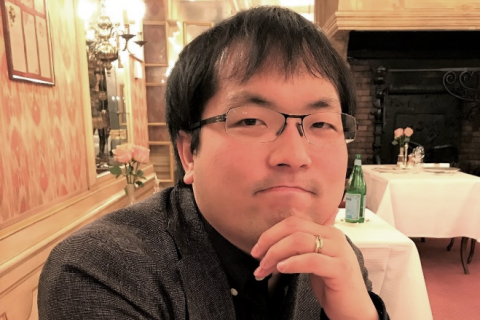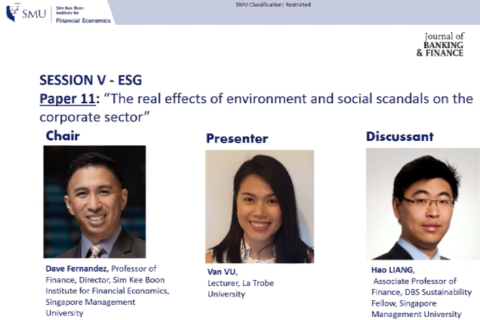
By Alvin Lee
SMU Office of Research & Tech Transfer – Rankings of universities are largely based on their research output and citations, a fact of life with which any academic is well acquainted. For SMU’s recently appointed Dean of the School of Economics (SOE), Professor Hoon Hian Teck, it represents the basic framework of his vision for the School.
“We regard what we do here as furthering the international research frontier, by which I mean that the School at its core sees itself as part of an international community of scholars,” Professor Hoon tells the Office of Research and Tech Transfer(ORTT). “It means essentially getting into the norm of having your ideas being evaluated by fellow scholars and, of course, there's a whole system for doing that in our School.
“The real measure is influence and being judged by external reviewers who are experts in your field.”
Research of the real world
Professor Hoon points out that “within the discipline of economics broadly as well as within specific areas, scholars know which are the top journals”, but it is more than a simple matter of who publishes more papers in these publications.
“Of course, if I have never published anything then I can’t say I have influence,” he notes. “I could have published two papers and someone else has published five, but my two papers could be really path-breaking work and they get highly cited.
“The discipline understands this [and] the international community of scholars is very tightly knit. Oftentimes, by the time you submit your paper to a journal, you would have done your round of attending the key seminars and conferences with colleagues working in your area of expertise.”
Professor Hoon singles out econometrics as an area in which SOE has been pushing the envelope, from SOE Assistant Professor Yichong Zhang’s work “in establishing the scientific reliability of common methods that are used broadly in the social sciences to look for what you may call cause and effect” to something on the cutting edge: machine learning and artificial intelligence.
“This whole field of econometrics is essentially about statistical tools applied to economic data,” observes Professor Hoon. Whereas traditional econometrics deal with specific parameters, such as the rate of time preference to indicate an individual’s propensity to spend, machine learning and artificial intelligence take into consideration plenty more parameters and data simultaneously to tackle a myriad of economic scenarios.
“This isn’t necessarily compatible with the usual sort of academic data that economists have traditionally used but it opens up the potential for economists to ask, ‘How reliable and how much more can you do with data generated either by machine learning or artificial intelligence?’” Professor Hoon observes, adding that the School is thinking of starting an econometrics centre on machine learning and data science.
He continues: “We have some interest from a couple of colleagues from the School of Information Systems (SIS) who know the technical aspect of machine learning. So there's some collaboration that can be very fruitful. In some sense, you could say that this aspect, particularly the economics machine learning and data science combination, contributes to the University's strategic priority of digital transformation.”
Research in the real world… of COVID-19
Professor Hoon emphasised that such developments could spill into new courses that will “help prepare our students for the working world because machine learning and artificial intelligence is shaking the foundations of how the workplace works”. It represents what the Dean calls the research-education nexus where “faculty engage in research and translate some of their discoveries to their education function”.
“You might call the other one the research-policy influence nexus,” he adds. “If you have a deeper understanding of, say, the labour market, you ought to be able to translate your findings in a way to communicate them to laymen and policymakers.
“Policymakers are constantly grappling with issues in the real world and they would like professors to be able to translate findings in a way they can relate to.”
One issue policymakers and governments are dealing with is, inevitably, COVID-19. Even though Professor Hoon is not directly studying the economic impact of the pandemic, the resulting travel restrictions and virtual webinars in place of face-to-face meeting have led to the loss of invaluable in-person interaction that often sparks new ideas.
“My SOE colleagues have found that the level of feedback has reduced in its efficacy,” says Professor Hoon even as he praises the University’s efforts in implementing virtual meeting software such as Zoom and Microsoft Teams. “After a physical seminar you can go have a dinner and talk a lot more [but] you can’t do that now. In the past I might take three months to achieve a certain level of feedback, but now maybe I need six months.
“I think the cost is in fact far higher because economists are essentially the creators of ideas. When you have a bigger gathering of people, ideas spill over and multiply in terms of the feedback and so on, and that is lost. So I think we have to recognise there is a real setback for faculty in doing their research.”
A dream come true
Nevertheless, Professor Hoon is planning ahead for the resumption of international travel, budgeting for visits by acclaimed economists to facilitate the in-person conversations that have been sorely missed. The Dean is also working on his current research project in collaboration with Professor Gylfi Zoega at the University of Iceland and Columbia University’s Professor Edmund Phelps, the 2006 recipient of the Nobel Prize for Economics.
“The three of us are trying to understand the reason behind the relatively high interest rates in the early 1980’s and how the real interest rates steadily declined from then,” explains the Dean, relating to ORTT his deep dive into supply-side policies most often associated with U.S. President Ronald Reagan. “I am working on the theory to explain why real interest rates were as high as they were, and Gylfi is looking at the empirical evidence from a hundred years’ worth of data.”
As graduate students at Columbia University, both Professors Hoon and Zoega had worked with Professor Phelps in the mid-80s. For Professor Hoon, it was a dream come true.
“There was the Phillips curve and a big paper in 1968 in particular, and people knew that he was in the line for the Nobel Prize,” Professor Hoon recounts, referring to Professor Phelps’s paper Money-Wage Dynamics and Labor-Market Equilibrium. “As a graduate student, one of my dreams was that Professor Phelps and I might do a paper together but he has many generations of graduate students.
“In 1988 I took one of his advanced classes. He was in his office and he asked me to come around to his table where he was drafting some equations to study… the high unemployment in Europe.
“He became one of my supervisors, and I worked with him and we published a paper in 1992 which tried to explain what we call structural unemployment,” the Dean recounts, referring to “Macroeconomic Shocks in a Dynamized Model of the Natural Rate of Unemployment”. “He was trying to explain that, so my dream came true.”
Back to Research@SMU Nov 2020 Issue
See More News
Want to see more of SMU Research?
Sign up for Research@SMU e-newslettter to know more about our research and research-related events!
If you would like to remove yourself from all our mailing list, please visit https://eservices.smu.edu.sg/internet/DNC/Default.aspx

